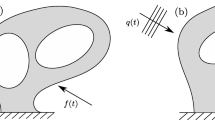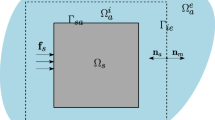Abstract
Sound quality is one of the essential criteria for measuring the acoustic performance of acoustic devices. In contrast to the optimization of sound characteristics, both the quantitative description of sound quality and the numerical instability that may occur during optimization need to be investigated. In the present work, an explicit topology optimization approach is proposed to enhance the sound quality of acoustic–mechanical structures, where the sound quality is described, resorting to frequency response within a specified frequency band. To this end, the moving morphable component (MMC)-based approach is adopted to achieve the explicit topology design, and the mixed finite element method is introduced to evaluate the sound quality. With the use of the explicit description of MMC, the acoustic-structure boundary can be captured accurately, which is important for acoustic response analysis. Moreover, a regularization topology optimization formulation is also developed to avoid the numerical issues produced in some special frequency bands. Numerical examples demonstrate the effectiveness of the proposed approach in improving sound quality performance.








Similar content being viewed by others
Availability of Data and Material
The data and material used or analyzed during the current study are available from the corresponding authors on reasonable request.
References
Kim HK, Jiang YW, Xu DP, Kwon JH, Hwang SM. Practical design of a speaker box with a passive vibrator (February 2018). IEEE Access. 2018;6:11443–51.
Barbieri R, Barbieri N. Acoustic horns optimization using finite elements and genetic algorithm. Appl Acoust. 2013;74(3):356–63.
Conlon TW, Nishisaki A, Singh Y, et al. Moving beyond the stethoscope: diagnostic point-of-care ultrasound in pediatric practice. Pediatrics. 2019;144(4):e20191402.
Ooi K, Xie Y, Lam B, Gan WS. Automation of binaural headphone audio calibration on an artificial head. MethodsX. 2021;8:101288.
Dilgen CB, Dilgen SB, Aage N, Jensen JS. Topology optimization of acoustic mechanical interaction problems: a comparative review. Struct Multidiscip Optim. 2019;60(2):779–801.
Zhao WC, Chen LL, Chen HB, Marburg S. Topology optimization of exterior acoustic–structure interaction systems using the coupled FEM–BEM method. Int J Numer Meth Eng. 2019;119(5):404–31.
Chen N, Yu DJ, Xia BZ, Liu J, Ma ZD. Microstructural topology optimization of structural-acoustic coupled systems for minimizing sound pressure level. Struct Multidiscip Optim. 2017;56(6):1259–70.
Xu ZX, Gao H, Ding YJ, Yang J, Liang B, Cheng JC. Topology-optimized omnidirectional broadband acoustic ventilation barrier. Phys Rev Appl. 2020;14(5):054016.
Fujii G, Takahashi M, Akimoto Y. Acoustic cloak designed by topology optimization for acoustic-elastic coupled systems. Appl Phys Lett. 2021;118(10):101102.
Ma L, Cheng L. Topological optimization of damping layout for minimized sound radiation of an acoustic black hole plate. J Sound Vib. 2019;458:349–64.
Kim KH, Yoon GH. Optimal rigid and porous material distributions for noise barrier by acoustic topology optimization. J Sound Vib. 2015;339:123–42.
Cerjan C, Kosloff D, Kosloff R, Reshef M. A nonreflecting boundary condition for discrete acoustic and elastic wave equations. Geophysics. 1985;50(4):705–8.
Mugnolo D. Abstract wave equations with acoustic boundary conditions. Math Nachr. 2006;279(3):299–318.
Boukhatem Y, Benabderrahmane B. Existence and decay of solutions for a viscoelastic wave equation with acoustic boundary conditions. Nonlinear Anal Theory Methods Appl. 2014;97:191–209.
Kook J, Jensen JS. Topology optimization of periodic microstructures for enhanced loss factor using acoustic–structure interaction. Int J Solids Struct. 2017;122:59–68.
Noguchi Y, Yamada T. Level set-based topology optimization for graded acoustic metasurfaces using two-scale homogenization. Finite Elem Anal Des. 2021;196:103606.
Shu L, Wang MY, Ma ZD. Level set based topology optimization of vibrating structures for coupled acoustic-structural dynamics. Comput Struct. 2014;132:34–42.
Desai J, Faure A, Michailidis G. Topology optimization in acoustics and elasto-acoustics via a level-set method. J Sound Vib. 2018;420:73–103.
Picelli R, Vicente WM, Pavanello R, Xie YM. Evolutionary topology optimization for natural frequency maximization problems considering acoustic–structure interaction. Finite Elem Anal Des. 2015;106:56–64.
Pedersen NL. Maximization of eigenvalues using topology optimization. Struct Multidiscip Optim. 2000;20(1):2–11.
Yoon GH, Jensen JS, Sigmund O. Topology optimization of acoustic–structure interaction problems using a mixed finite element formulation. Int J Numer Meth Eng. 2007;70(9):1049–75.
Kook J. Evolutionary topology optimization for acoustic–structure interaction problems using a mixed u/p formulation. Mech Based Des Struct Mach. 2019;47(3):356–74.
Hu J, Yao S, Huang XD. Topology optimization of dynamic acoustic–mechanical structures using the ersatz material model. Comput Methods Appl Mech Eng. 2020;372:113387.
Du JB, Olhoff N. Minimization of sound radiation from vibrating bi-material structures using topology optimization. Struct Multidiscip Optim. 2007;33(4):305–21.
Du JB, Olhoff N. Topological design of vibrating structures with respect to optimum sound pressure characteristics in a surrounding acoustic medium. Struct Multidiscip Optim. 2010;42(1):43–54.
Dühring MB, Jensen JS, Sigmund O. Acoustic design by topology optimization. J Sound Vib. 2008;317(3–5):557–75.
Letowski T. Sound quality assessment: concepts and criteria. Audio Engineering Society Convention 87. Audio Engineering Society; 1989.
Guo X, Zhang WS, Zhong WL. Doing topology optimization explicitly and geometrically—a new moving morphable components based framework. J Appl Mech. 2014. https://doi.org/10.1115/1.4027609.
Zhang WS, Li DD, Kang P, Guo X, Youn SK. Explicit topology optimization using IGA-based moving morphable void (MMV) approach. Comput Methods Appl Mech Eng. 2020;360:112685.
Zhang WS, Yan XY, Meng Y, Zhang CL, Youn SK, Guo X. Flexoelectric nanostructure design using explicit topology optimization. Comput Methods Appl Mech Eng. 2022;394:114943.
Sun JL, Tian Q, Hu HY, Pedersen NL. Topology optimization for eigenfrequencies of a rotating thin plate via moving morphable components. J Sound Vib. 2019;448:83–107.
Bai JT, Zuo WJ. Hollow structural design in topology optimization via moving morphable component method. Struct Multidiscip Optim. 2020;61(1):187–205.
Denimal E, Renson L, Wong C, Salles L. Topology optimization of friction under-platform dampers using moving morphable components and the efficient global optimization algorithm. Struct Multidiscip Optim. 2022;65(2):1–19.
Hoang VN, Nguyen NL, Nguyen-Xuan H. Topology optimization of coated structure using moving morphable sandwich bars. Struct Multidiscip Optim. 2020;61(2):491–506.
Nguyen HD, Hoang VN, Jang GW. Moving morphable patches for three-dimensional topology optimization with thickness control. Comput Methods Appl Mech Eng. 2020;368:113186.
Zhao YF, Hoang VN, Jang GW, Zuo WJ. Hollow structural topology optimization to improve manufacturability using three-dimensional moving morphable bars. Adv Eng Softw. 2021;152:102955.
Zhang SL, Gain AL, Norato JA. Adaptive mesh refinement for topology optimization with discrete geometric components. Comput Methods Appl Mech Eng. 2020;364:112930.
Smith H, Norato JA. Topology optimization with discrete geometric components made of composite materials. Comput Methods Appl Mech Eng. 2021;376:113582.
Ma ZD, Kikuchi N, Cheng HC. Topological design for vibrating structures. Comput Methods Appl Mech Eng. 1995;121(1–4):259–80.
Ma ZD, Kikuchi N, Hagiwara I. Structural topology and shape optimization for a frequency response problem. Comput Mech. 1993;13(3):157–74.
Zhang WS, Yuan J, Zhang J, Guo X. A new topology optimization approach based on moving morphable components (MMC) and the ersatz material model. Struct Multidiscip Optim. 2016;53(6):1243–60.
MATLAB. https://ww2.mathworks.cn/help/parallel-computing/parallel.pool.html.
Svanberg K. The method of moving asymptotes—a new method for structural optimization. Int J Numer Meth Eng. 1987;24(2):359–73.
Funding
The financial support from the Foundation for Innovative Research Groups of the National Natural Science Foundation (11821202), the National Natural Science Foundation (12272075), Liaoning Revitalization Talents Program (XLYC2001003, XLYC1907119), and Fundamental Research Funds for the Central Universities (DUT22QN238) are gratefully acknowledged.
Author information
Authors and Affiliations
Contributions
WZ and XG designed the study; LX performed the research; ZL analyzed data; all authors contributed to the writing and revisions.
Corresponding authors
Ethics declarations
Conflict of interest
The authors declare that they have no competing interests.
Ethical Approval and Consent to Participate
This article does not contain any studies with human participants or animals performed by any of the authors.
Consent for Publication
Consent for publication has been obtained from all individual participants included in the study.
Rights and permissions
Springer Nature or its licensor (e.g. a society or other partner) holds exclusive rights to this article under a publishing agreement with the author(s) or other rightsholder(s); author self-archiving of the accepted manuscript version of this article is solely governed by the terms of such publishing agreement and applicable law.
About this article
Cite this article
Xu, L., Zhang, W., Liu, Z. et al. Topology Optimization of Acoustic–Mechanical Structures for Enhancing Sound Quality. Acta Mech. Solida Sin. 36, 612–623 (2023). https://doi.org/10.1007/s10338-023-00408-w
Received:
Revised:
Accepted:
Published:
Issue Date:
DOI: https://doi.org/10.1007/s10338-023-00408-w




